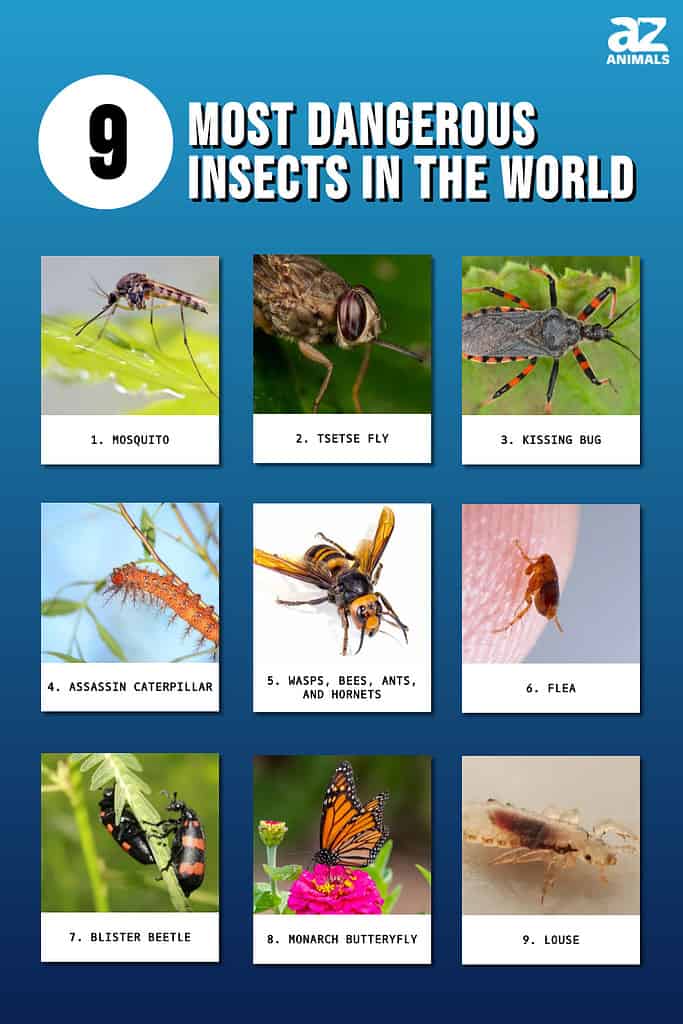When it comes to spreading illnesses and diseases, even life-threatening ones, insects are nearly the perfect vectors. They are small in size, and many have piercing or chewing mouthparts that can easily inject pathogens into the bloodstream. Hornets, bees, ants, and wasps have stings that deliver venom that can kill or badly injure people who are allergic to them.
This article lists the most dangerous, venomous, and poisonous insects that cause disease and death as opposed to those whose bites or stings cause pain, even mind-boggling pain, but no other side effects. The list also leaves out insects that are not directly harmful to people but can be harmful in other ways, such as locusts that strip fields of crops in a night. Read on to learn about the most venomous insects and the deadliest bugs in the world:
#9: Louse
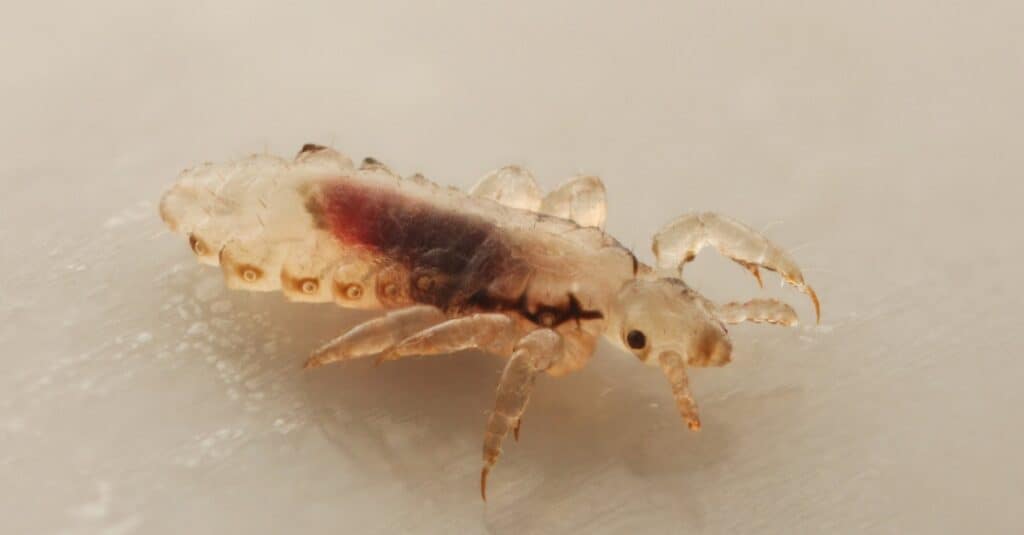
©iStock.com/DeVil79
Humans have been dealing with these tiny, wingless blood-sucking bugs for millennia. They are obligated to feed on warm-blooded animals, and there’s a louse for just about every animal who is not a bat, an egg-laying mammal such as a platypus or a pangolin. The louse is a primitive insect, and they are so ubiquitous that there’s a name for a mental disorder where people believe they’re infested with lice but aren’t. It’s called delusional parasitosis.
No class of society has been free from lice, not kings nor clergy nor humble laborers nor soldiers. It may not be a stretch to say that lice saved the life of J.R.R. Tolkien, who contracted trench fever from a louse infestation in World War I and had to be sent home from the front to recover. Besides trench fever, lice are notorious vectors of typhus, a dangerous disease caused by bacteria.
#8: Monarch Butterfly
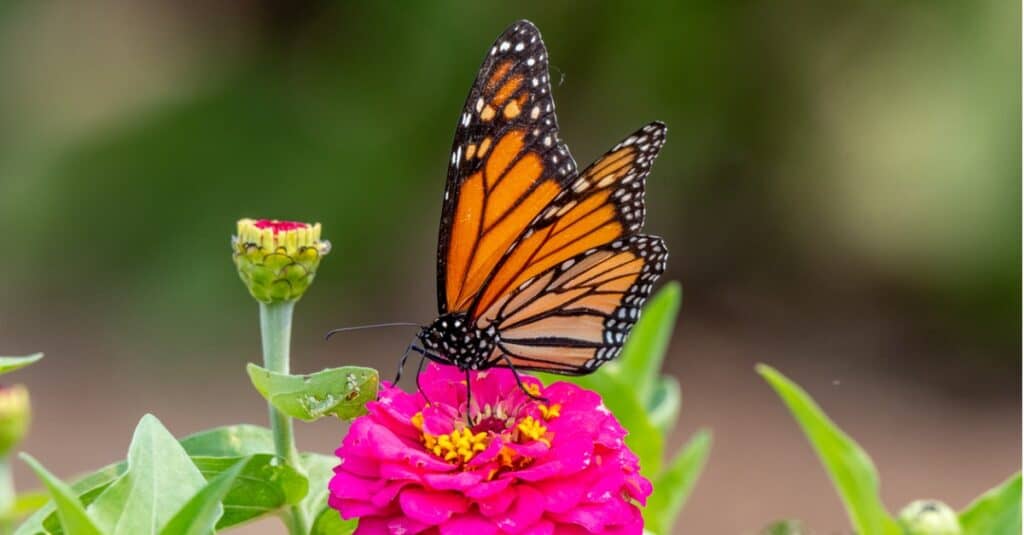
©iStock.com/Christophe Merceron
The larvae of some insects are edible and even nutritious, but this is not true of the monarch butterfly. The innocent, beautiful, and revered monarch is one of the most poisonous insects on the planet. It does not bite or sting, not even as a pretty, tiger-striped caterpillar. But it will kill a human who tries to eat it. This is because the caterpillar feeds almost exclusively on milkweed. As it does this, it takes the milkweed toxin into its body and stores it. The toxin is present even when the caterpillar pupates and turns into an adult. A person or animal who eats the monarch will get a good dose of milkweed poison, which can lead to cardiac arrest.
Go here to learn about monarch butterflies.
#7: Blister Beetle
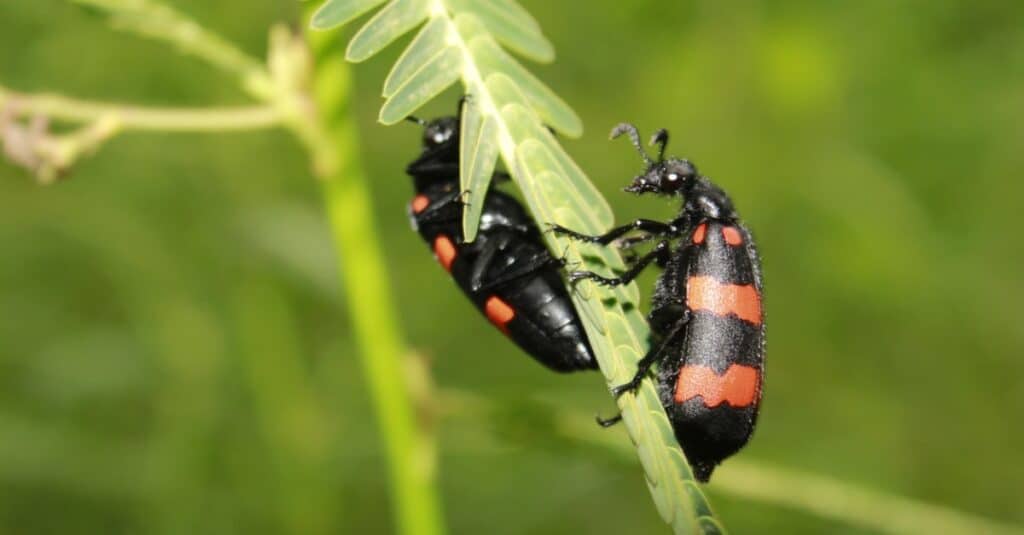
©iStock.com/MANORANJAN MISHRA
The blister beetle is also one of the most poisonous insects. That is, it should not be eaten or even handled, for it secretes a chemical called cantharidin. Cantharidin raises blisters on the skin, though if it’s used properly it can remove warts. However, if a person seeks to eat the beetle, the cantharidin destroys the lining of the GI tract and can lead to death. As people aren’t very inclined to eat these poisonous insects, the real danger of blister beetles is to farm animals. The beetles are attracted to alfalfa, and if they are ground up in alfalfa hay as it’s being prepared, the released cantharidin of even a few blister beetles can be enough to kill a horse. Blister beetles belong to the Meloidae family and there are over 7000 species. Most of them are brilliantly colored, and brilliant coloration is a sign that these bugs need to be left alone.
Read this to learn more about beetles.
#6: Flea
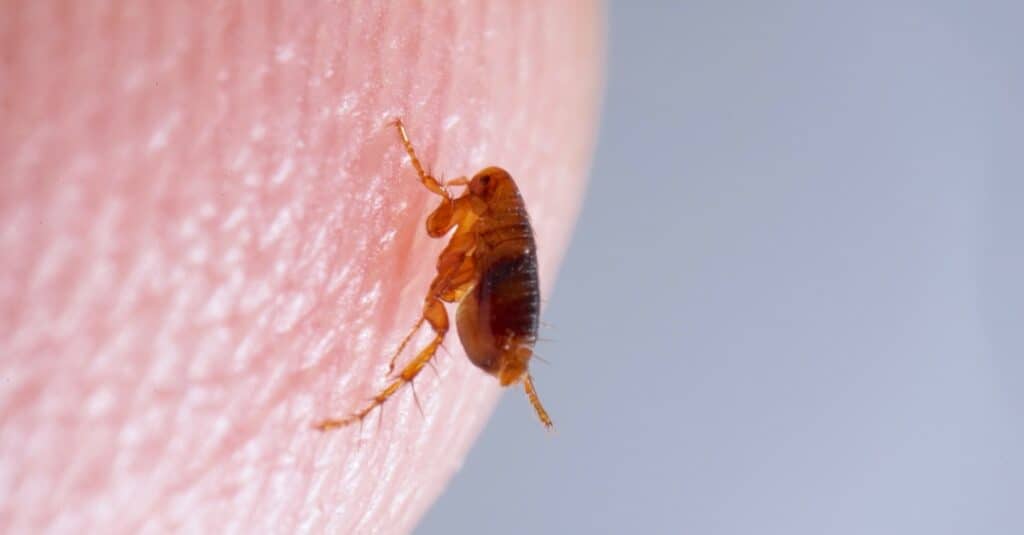
©iStock.com/S.Rohrlach
Like lice, fleas are primitive wingless insects that make a living sucking the blood of other animals. They sometimes even parasitize those animals that are distasteful to lice, such as bats. Fleas compensate for their inability to fly with their ability to jump. They can jump as much as 200 times the length of their tiny bodies, the equivalent of a 6-foot-tall human leaping 1200 feet into the air.
A fleabite by itself can cause itching and inflammation, and an infestation can be so severe that the host animal can develop anemia. But it is as a vector of the deadly disease that this tiny insect comes into its own. Fleas transmit all manner of pathogens, including viruses, bacteria, and worms. The diseases these creatures transmit include typhus and famously, the bubonic plague. This plague wiped out 50 million people and destroyed much of the population of Europe in the 14th century. Fleas also transmit tapeworms and Trypanosoma protozoans which can cause sleeping sickness and Chagas disease. Though the plague is no longer common around the world and can be treated with a course of antibiotics, fleas are responsible for a ghastly skin disease called tungiasis. This disease causes inflammation of the skin, itching, and sores.
#5: Wasps, Bees, Ants, And Hornets
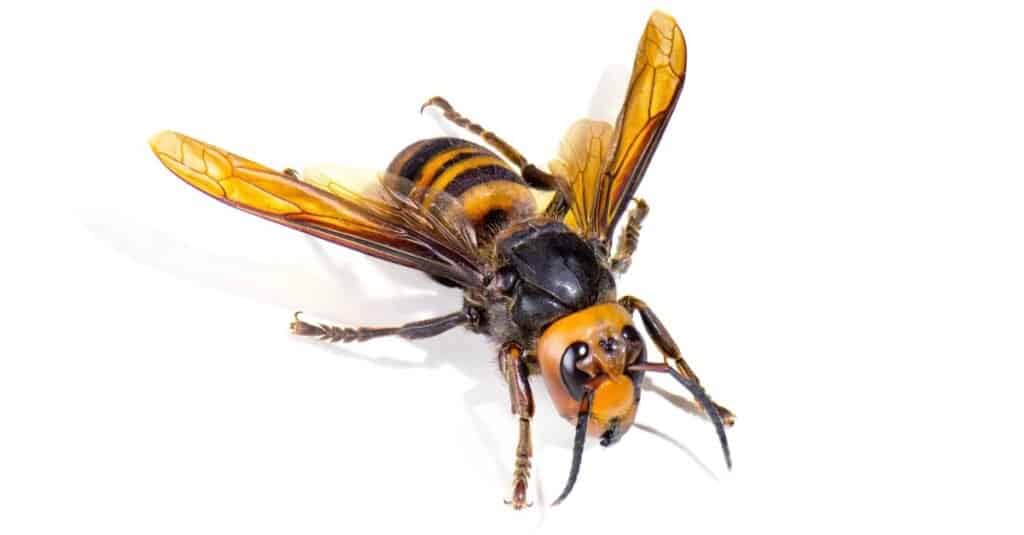
©iStock.com/kojihirano
These largely beneficial but still dangerous insects belong to the Hymenoptera order. Hymmenoptrans are probably the most venomous insects on earth. The females sting, and sometimes those stings are harmful beyond causing severe pain. Some people are allergic to the stings of hymenopterans and must receive prompt medical care lest they go into shock.
The Asian giant hornet, nicknamed the murder hornet because of its habit of attacking and killing honeybees, is the largest of the wasps and can be 2 inches in size. It not only has a more powerful venom than most hymenopterans but seems to be able to spray it into people’s eyes as well as deliver it with its stinger. Yet even this wasp isn’t the most venomous. That title goes to a Philippine species called Vespa luctuosa. Its sting is not only excruciating but can lead to convulsions, blood in the urine, and cyanosis.
Go here, here, and here to learn more about hymenopterans.
#4: Assassin Caterpillar
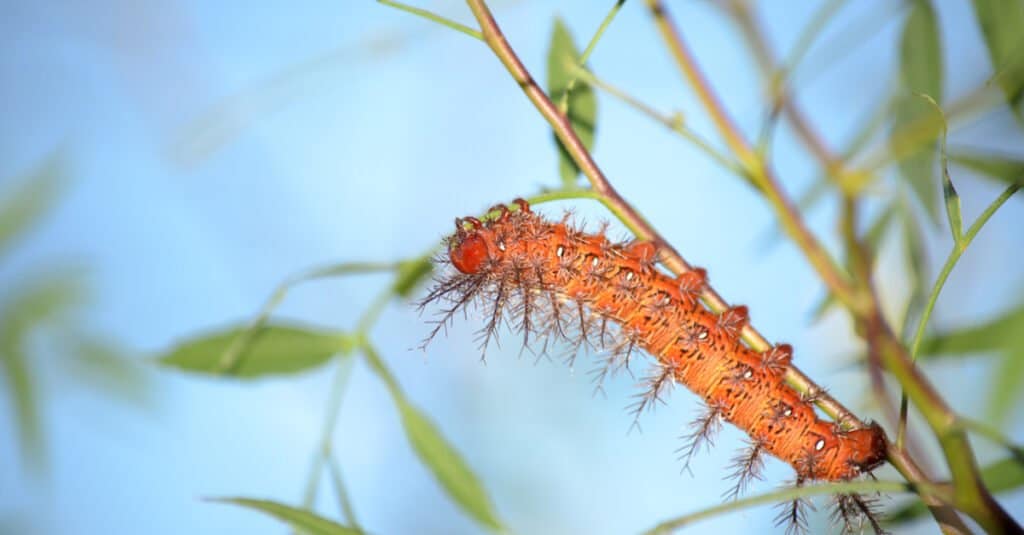
©Joab Souza/Shutterstock.com
The caterpillar of Lonomia obliqua eventually turns into a large, rather pretty brown silkworm moth. Native to South America, it is harmless and like other silkworm moths, doesn’t even eat. The caterpillar, however, is one of the deadliest insects in the Americas. It grows to about 2 inches long in size and can be green, gray, or brown, and it is covered with spines. These spines detach very easily, pierce the skin and deliver a venom that interrupts the blood’s ability to clot. If a person is exposed to enough of this venom, it will kill them as their vital organs, including the brain, start to hemorrhage. Since one spine of the caterpillar is tiny and delivers a minuscule amount of venom, a person will need to be stung over and over and over to experience harmful effects. As Lonomia obliqua caterpillars like to congregate and are very well camouflaged, this is a possibility.
Read this for more information about caterpillars.
#3: Kissing Bug
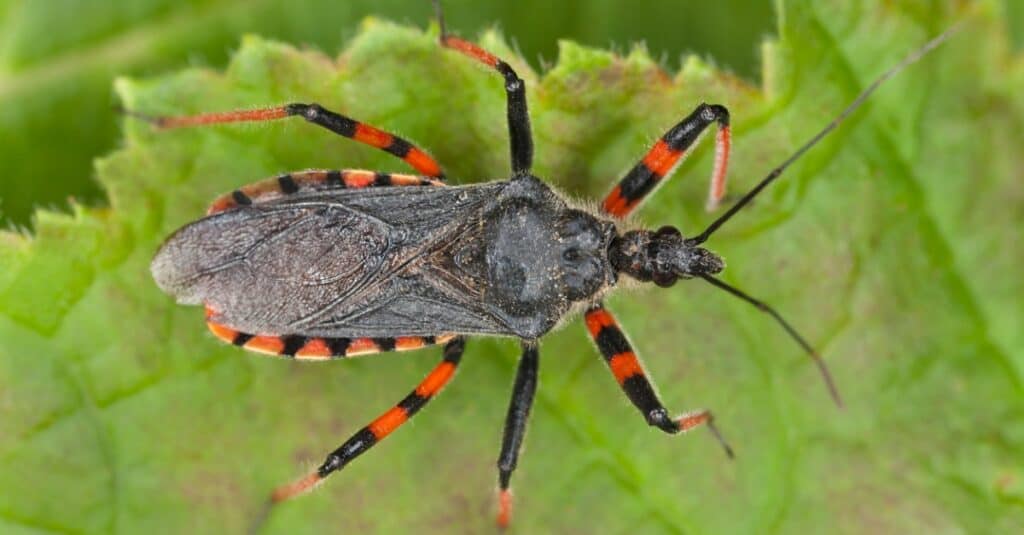
©Henrik Larsson/Shutterstock.com
Insects such as the mosquito are tidy when they bite. The kissing bug is not, which adds to its gruesomeness. There are 130 species of this insect, and a couple of them are responsible for spreading Chagas disease. Chagas disease is an especially sinister ailment that it doesn’t cause life-threatening symptoms until 10 to 30 years after the person is bitten. One symptom is usually heart disease, and the person can also develop problems with their digestive tract and their nervous system.
One type of this harmful bug, Rhodnius prolixus has an incomplete metamorphosis, much like a grasshopper. A nymph hatches from an egg, and the insect just gets bigger through molting. It needs blood in order for it to molt successfully. To this end, the insect often crawls upon the face of a person who’s asleep and bites them near their mouth, which gives it its common name. But the parasite, Trypanosoma cruzi, often doesn’t enter through the insect’s saliva. When the kissing bug is finished, it defecates. The protozoan and its disease are delivered when the person scratches the wound and infects it with the insect’s parasite-bearing feces.
#2: Tsetse Fly
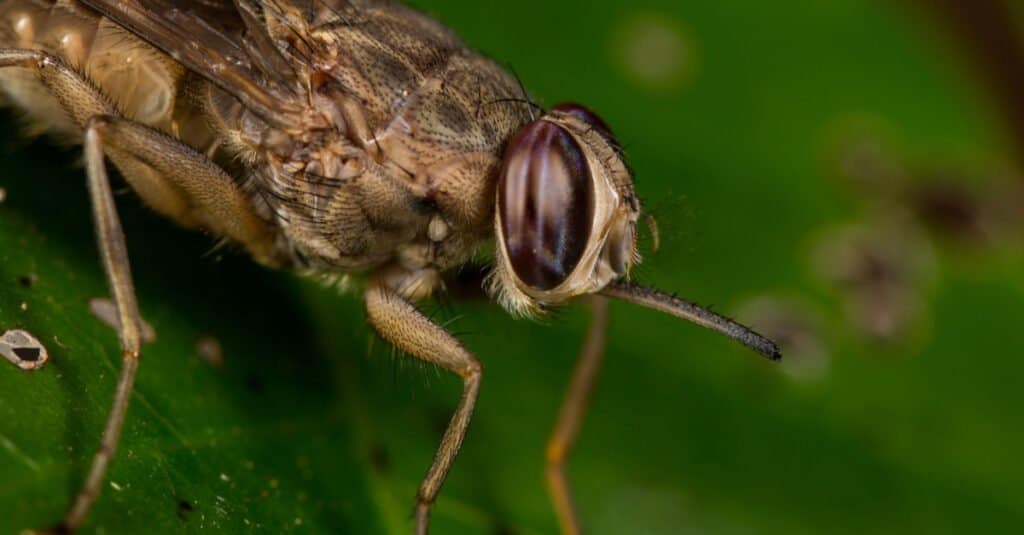
©Jaco Visser/Shutterstock.com
These very odd and dangerous insects which feed their larvae with milk and give birth to them in that order are found in tropical Africa. The tsetse fly is responsible for one of the most devastating human diseases, sleeping sickness. Like the kissing bug, the tsetse is a vector of trypanosomes. The parasite that causes sleeping sickness is Trypanosoma brucei and its subspecies. The fly can transmit the parasite that it’s gotten from an infected host or it can transmit parasites that are parasitizing its own body.
Like Chagas disease, sleeping sickness takes a while to do its dirty work. About one to three weeks after a person is bitten they become feverish and headachy, with joint pains and itchiness. They can also have swollen lymph nodes and a rash. The second stage can happen even months after this as the parasite infests the person’s nervous system. Then, the patient becomes confused and insomniac and suffers a loss of balance. Sometimes the first and second stages blend into each other, and the patient needs a spinal tap to tell the doctor which stage they’re in. If the person isn’t treated, they will lapse into a coma, suffer organ failure and die. Fortunately, sleeping sickness can be treated, and the number of deaths is decreasing.
Go here for more information about the tsetse fly.
#1: Mosquito
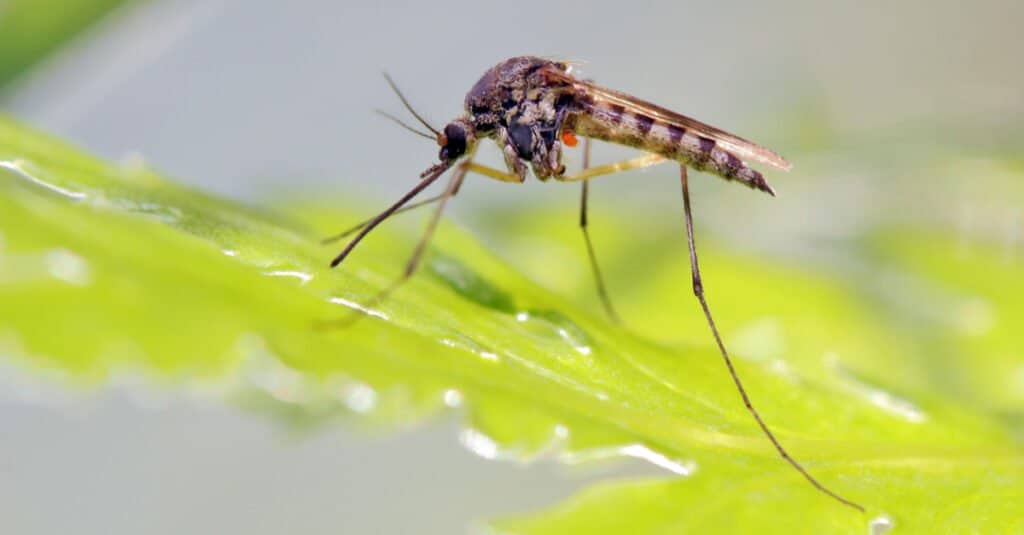
©Achkin/Shutterstock.com
The Anopheles mosquito is far and away the deadliest of dangerous insects. The parasite injected from the bite of this tiny creature causes more deaths and illnesses than the bite or sting of any other insect. It’s all because the female mosquito, like most female mosquitoes, needs a blood meal so that she can have babies. In 2019, 409,000 people died of malaria, most of them children under five.
However, malaria isn’t the only ailment delivered by mosquitoes. Others include:
• Chagas disease
• Dengue or breakbone fever
• West Nile virus
• Zika virus
• Rift Vally fever
• Chikungunya fever
• Yellow fever
• St. Louis encephalitis
Learn more about mosquitoes here.
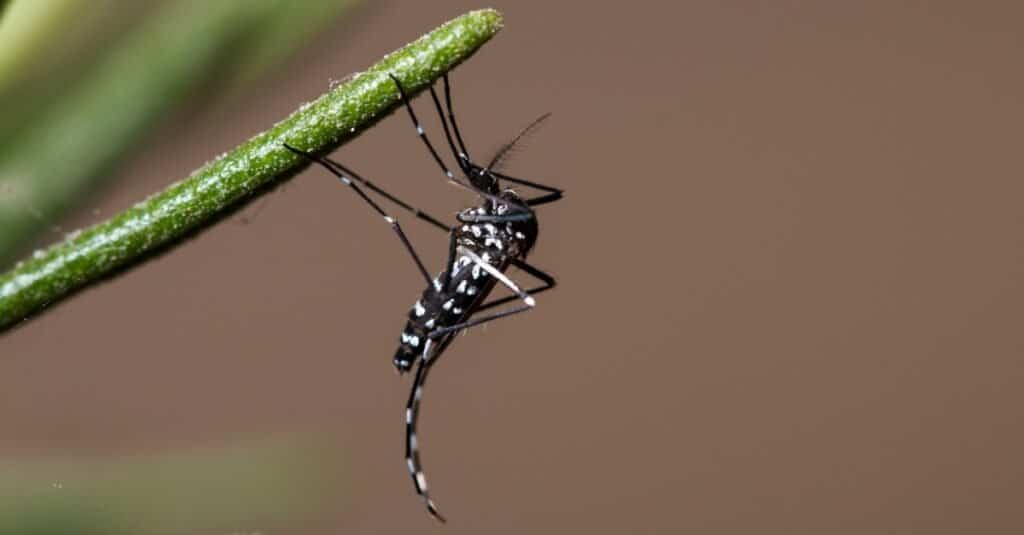
Mosquito is responsible for transmitting several diseases, including the West Nile virus.
©Oliver Spiteri/Shutterstock.com
What is the Strongest Insect in the World?
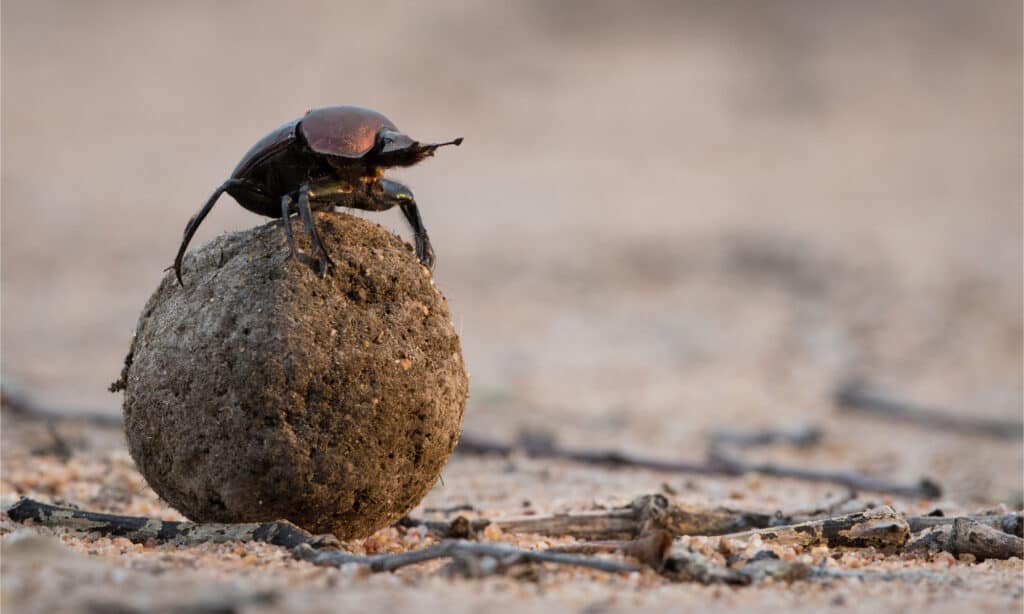
©Villiers Steyn/Shutterstock.com
So we know which insects to avoid because they are dangerous and sometimes venomous, but let us take a look at which insect is the most buff!
With a life dedicated to rolling, lifting, and stacking piles of poo, the dung beetle is able to lift incredible amounts of weight. The horned dung beetle specifically can move the most and in fact over 1,000 times its own body weight! Can you imagine being able to not only shoulder an item one thousand times heavier than you can now but also having to do that all day?
Interestingly, male versions of these horned critters will lock horns to fight for a mate which tunnels underneath a dung ball. On a diminutive scale, it must look like something out of a superhero movie because of their amazing strength-to-size ratio.
Summary of the Most Dangerous Insects in the World
